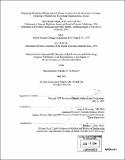Managing revisions of rules and guidelines used in clinical information systems : exploring a hierarchical knowledge representation model
Author(s)
Scott-Wright, Alicia, 1949-
DownloadFull printable version (2.503Mb)
Other Contributors
Harvard University--MIT Division of Health Sciences and Technology.
Advisor
Aziz A. Boxwala.
Terms of use
Metadata
Show full item recordAbstract
One important purpose for creating clinical practice guidelines is to improve quality of care by reducing variations in practice. In the current healthcare environment, guidelines are being advocated as a means to disseminate research findings, standardize care, improve quality of care, and increase the cost-effectiveness of health care services. Unfortunately, compliance with text-based clinical practice guidelines is unsatisfactory. On the other hand, adherence to guideline recommendations is increased when providers receive patient-specific recommendations during the patient-provider consultation. Guideline-based point of care decision support systems have been shown to increase provider consultation. Guideline-based point of care decision support systems have been shown to increase provider adherence to guideline recommendations. Computer-interpretable formats for clinical practice guidelines are a prerequisite for decision support systems. The development process of a text-based clinical practice guideline is long and arduous and in most cases this process is repeated when text-based guidelines are revised to include new medical knowledge. Clearly, once text-based guideline knowledge is translated into a computer-interpretable format, the computer-interpretable guideline would also require periodic revisions to maintain the integrity of its evidence-base. Therefore, representation formalisms for encoding guideline knowledge into computer-interpretable formats should enable easy revisions of the encoded guidelines. This thesis describes a study I conducted to demonstrate that modular knowledge representation of clinical practice guidelines facilitates easy guideline revisions. To test the hypothesis (cont.) hypothesis, I used a methodology for modular representation of guidelines, HieroGLIF, developed by Decision Systems Group, Brigham and Women's Hospital, Boston Massachusetts. HieroGLIF uses Axiomatic Design theory to encode "guideline knowledge modules" into a hierarchical tree structure. Axiomatic Design theory was developed in the field of engineering as a principled approach to product design. I applied HieroGLIF to encode parts of three outdated guidelines. I revised these designs to model updated guideline releases. Quantitative metrics assessed the adequacy of the tool to encode generic setting-independent guidelines and to facilitate revisions in encoded guidelines without complete recoding of the model. This work explores the use of HieroGLIF and Axiomatic Design theory to facilitate revisions of computer-interpretable guidelines.
Description
Thesis (S.M.)--Harvard-MIT Division of Health Sciences and Technology, 2004. Includes bibliographical references (leaves 46-51).
Date issued
2004Department
Harvard University--MIT Division of Health Sciences and TechnologyPublisher
Massachusetts Institute of Technology
Keywords
Harvard University--MIT Division of Health Sciences and Technology.